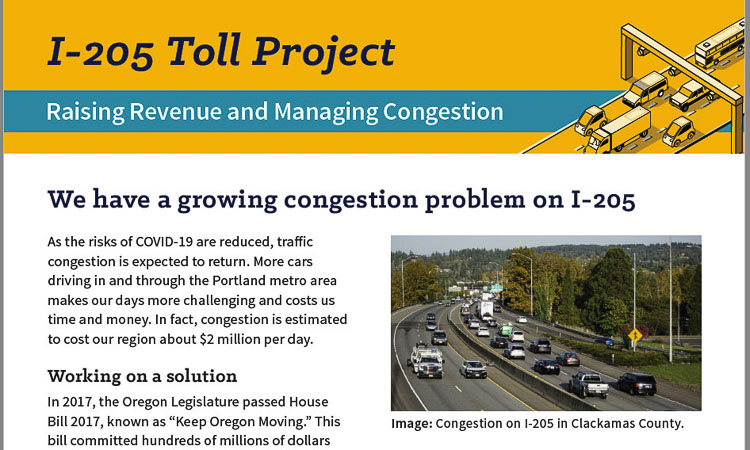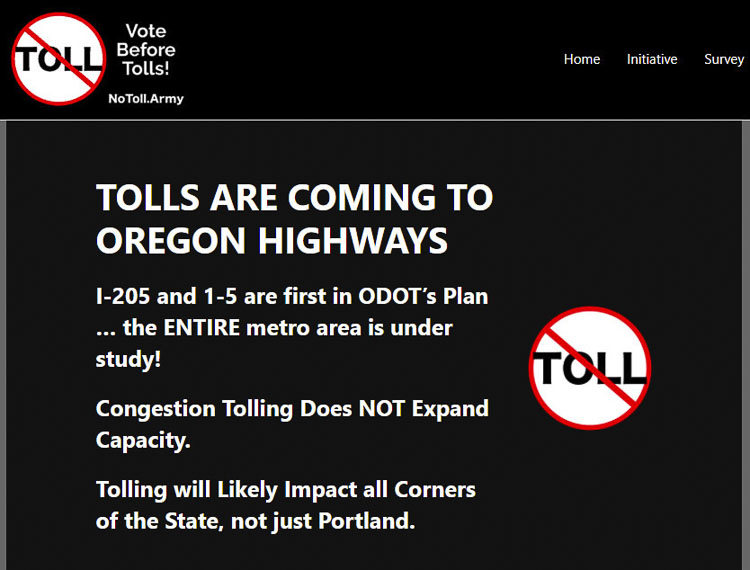
Creating financial hardship for low income workers and unfairness for Clark County residents at issue
At Monday night’s Vancouver City Council meeting, councilors received updates on both the Interstate Bridge Replacement Program (IBR) and Oregon’s plans for tolling sections of I-5 and I-205 starting “at the border” with Washington.
Following the briefings from staff, Councilor Bart Hansen pushed back. Hansen said he understands and supports the need for tolling to pay for part of replacing the Interstate Bridge. However, he believes Oregon’s congestion pricing will be punitive and harm low income residents in Vancouver and Southwest Washington. Fellow Council Member Ty Stober asked for a deeper dive into the numerous issues surrounding tolling.
The Oregon State Legislature passed HB2017 in July 2017. The $5.2 billion transportation package funded a variety of statewide transportation projects, including money for the I-5 Rose Quarter project and the I-205 Abernethy Bridge project. Legislators included language directing ODOT to “study” tolling I-5 and I-205 from the Washington border down to where the freeways merge near Wilsonville. At the time of its passage, state officials expected a 46.5 percent increase in revenue according to the staff report.
Today, there are three different tolling discussions, according to Katherine Kelly, Vancouver senior policy analyst. Tolling as part of funding a replacement Interstate Bridge, ODOT’s “congestion pricing” scheme that will charge varying rates in an effort to reduce traffic congestion on I-5 and I-205, and then Portland’s Regional Mobility Pricing Program that seeks to toll all area highways and freeways. Mayor Anne McEnerny-Ogle labeled it a “very complicated issue” Monday night.

Kelly shared that multiple Oregon agencies are involved in the discussions, adding to the confusion. “There are currently two separate timelines, two separate NEPA (National Environmental Policy Act) processes,” Kelly said. “But they are not aligned in terms of timing.”
“We need to quit talking and start acting,” said Hansen. He laments the council has been talking about the issue for years, and yet local citizens appear to be getting the short end of the stick.
“We need to be voting no,” Hansen said. “And when I’m talking about action, I think a resolution, I think a comment in NEPA, when it’s coming up, and also letters to the FHA. I think we need to take a much stronger stance on this, because I haven’t seen anything that benefits Clark County in any way or the city of Vancouver, when it comes to this.”
All Hansen has seen is how it negatively impacts low income people from Clark County that are working in Portland.
Council Member Diana Perez wanted to learn more about how all three programs come together and how they will impact the people. “It would be really beneficial if we had a very clear picture on all the intersections,” and how the programs work together.
Stober referenced multiple meetings and discussions back in 2018. Members of the council were briefed that only two options were being pursued, which would study impacts of tolling on small sections of I-5 in the downtown Portland area, and then on I-205 at the Abernethy Bridge. But Stober noted the entire discussion has morphed into something completely different than was discussed with the council in 2018.
“In August of that year, in response to several letters that had been written from our congressional delegation, (Oregon) Governor Brown’s administration wrote to (Washington) Senator Murray, that only those two options were being pursued,” he shared.
“What is being communicated,” according to Stober “is that . . . somehow a person in Clark County has a greater impact on the system than a commuter in Washington County, traveling the same number of miles on the same roadways.”
The staff memo provided a hint on how the program has morphed. “The Policy Advisory Committee met six times between November 2017 and May 2018, with Mayor Anne McEnerny-Ogle representing the City alongside representatives of other metro area jurisdictions and transportation advocacy organizations. There was no formal vote of this group.”
The proposals that didn’t receive a vote, or formal approval were heard by Mayor McEnerny-Ogle and other elected representatives, including Clark County Councilor Eileen Quiring O’Brien. They were two of 25 members of the “Value Pricing” Policy Advisory Committee (PAC) that spent seven months studying the staff and consultant directed options.
Councilors Bart Hansen and Ty Stober voiced opposition to Oregon’s multiple tolling programs for congestion pricing. They fear the tolls will harm low income Clark County and Vancouver residents. Video courtesy CVTV.org.
“Regarding the Value Pricing Committee, I believe the opinions of the hired consultants seem to be more valued than those of the actual committee members,’’ Quiring O’Brien told Clark County Today nearly four years ago.. “There are many voices on the committee but it seems that we have so much ground to cover that the facilitator ‘keeps us moving along.’
“The Advisory Committee clearly has no consensus about which direction they should go, but were reminded multiple times during the meeting that they are not a voting panel, and consensus wasn’t needed in order to move forward,’’ Clark County Today reported. “The group will meet for the final time on June 25 to firm up their recommendations, which will go to the Oregon Transportation Commission. The first chance the public will have to weigh in with OTC will be at their meeting on July 12.’’
“Like many government assembled committees that I have observed, unfortunately, it seems that ‘staff’ gets the lion’s share of the ‘juice’ – since they are considered the ‘professionals’ and we representatives (of groups or elected officials) or ‘citizen peons’ get a little time, but seemingly very little clout,’’ Quiring O’Brien said.
In a July 2018 visit to Vancouver, Gov. Jay Inslee pledged that Oregon’s scheme to toll Southwest Washington commuters for crossing the existing I-5 and I-205 bridges into Oregon “would not happen.”
Last fall, Congresswoman Jaime Herrera Beutler reminded citizens that Inslee made a promise to Southwest Washington citizens about Oregon’s plans for tolling, in a letter she wrote to the governor.
“When you yourself stated on July 31, 2018 that Oregon’s plan to toll existing I-5 and I-205 bridges at the state line “will not happen,” you gave hope to the tens of thousands of Washington commuters who would be impacted. Are you willing to follow through on that declaration and provide similar leadership at the state level to stand up and defend our shared constituents?”
With no apparent pushback from Washington state legislators nor Gov. Inslee, Hansen and others believe it is time to act.
“There are three tolls going on here,” Hansen said.
One for the bridge, which he understands the need for. It’s the ODOT and the congestion mitigation tolling he has problems with.
“They’re going directly after folks from Vancouver and Clark County,” he said. “For the life of me, I can’t understand why we’re not taking a more active role and saying, this is not good for us.”
Hansen needs to see something indicating they will help low income people trying to get to their jobs in Oregon. “I’m still a no on this,” he said.
In the past, Hansen has feared ODOT would be creating “roads for the rich” with their planned tolling system. At a Wednesday evening neighborhood association meeting, McEnerny-Ogle said low income individuals could be provided “no cost or low cost medallions,” indicating the windshield sticker that electronically collects the tolls. However, that has not been approved or even formally recommended by ODOT.

The Washington State Transportation Commission (WSTC) studied low income tolling programs last year. The commission hired a consultant team led by WSP USA to conduct technical work and to prepare the low income toll program report. WSP is the same consultant firm managing the Interstate Bridge Replacement Program, and is also working for ODOT on Oregon’s tolling program.
Nationally, there are very few discount toll programs. The WSTC report identified one toll discount program in Virginia providing a fixed discount of 75 cents per trip after the first eight trips per month, and a program in the Los Angeles area offering a one-time toll credit of $25 with waiver of a monthly $1 administrative fee. In addition, a Minnesota program offering annual toll credits to drivers with low incomes was proposed in 2017 but awaits authorization to implement.
The WSTC report found that a low income program could reduce tolling revenues by up to 20 percent, depending on assumptions for plan participation and system revenues.
ODOT says they “are committed to using congestion pricing on I-5 and I-205 through variable rate tolling as a vital tool to manage traffic in the Portland metro area.” They report that by 2040, Portland metro households will spend an average of 69 hours each year stuck in traffic congestion. What they don’t say is how much tolling will reduce those 69 hours.
At the end of the “Value Pricing” PAC process, Quiring summed up the experience. “I fear that it is a bit of a sham,’’ Quiring said. “I had high hopes at the beginning, but those hopes have all but dissolved.’’




